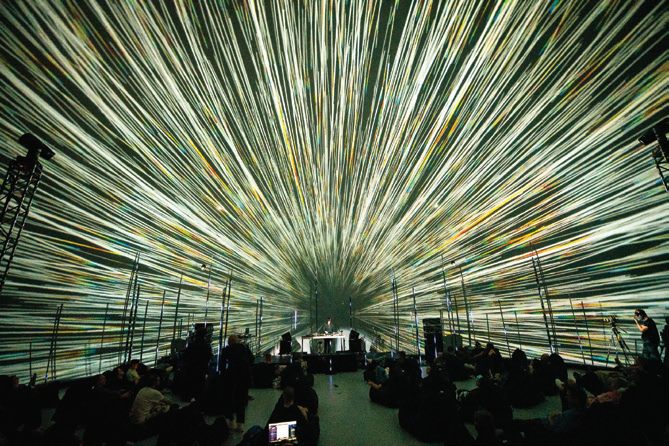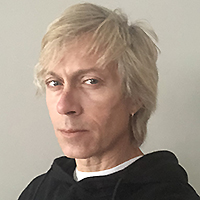Given the ever-evolving regulations governing live events during the pandemic, mounting the 2020 MUTEK electronic music and digital arts festival in Montreal required a high degree of agility on the part of everyone involved, including the artists, the individuals and companies tasked with providing designing the audio and visual systems, and the festival organizers.
Entitled “MUTEK 21 – A Virtual Exploration,” this year’s iteration featured performances in two Montreal venues – Cinquième Salle at Place des Arts and the Society for Arts and Technology (SAT) – each holding simultaneous, physically distanced in-person shows and livestreamed performances. As always with this festival, the types of performances varied widely, including live electronic acts, sets with full bands, a heavily effected solo harp performance, and an artist who set up 15 different amplifiers on stage as part of a loop-based, feedback-heavy presentation.
Return To Form
With fewer venues involved and far smaller (and socially distanced) audiences, this hybrid model was a departure from what participants have come to expect in recent years, but it was actually a return to form in some ways. “Strangely enough, when we started the festival in 2000, and for the next 10 years, we streamed the festival – just the audio – online,” notes Alain Mongeau, MUTEK founder as well as its general and artistic director. “We only stopped because we wanted people to develop the habit of coming to Montreal to experience MUTEK firsthand. We wanted to provoke a certain sense of FOMO (fear of missing out) – the notion that you have to be there to fully experience it.”
Granted, the atmosphere this year was odd, he continues: “People had to be sitting. Normally they’d be standing and dancing. But their attention was much more focused. During performances they didn’t react much, so sometimes it felt more like you were in a library,” he adds, chuckling. “But at the end of each set they were bursting and really showed their appreciation.”

That said, this year’s event definitely fit in well with the festival’s mandate to celebrate innovation and creativity, musically and technologically, Mongeau feels, owing to the implementation of a custom livestream platform developed by the organizers and by virtue of the audio systems, which included use of Meyer Sound’s (then yet-to-be-released) Spacemap GO for iPad spatial sound design and mix platform.
“We were very happy about the fact that we could display advances in sound technology in the festival,” he says, noting that along with the systems deployed for performances, successfully navigating the complexities of mounting MUTEK while dealing with changing health regulations also underscored the festival’s preoccupation with innovation and experimentation.
Although normally presented in August, this year’s event was pushed back to the second week of September. Mongeau: “We were about to announce the first wave of content when the pandemic hit, so in mid-March we suspended everything. By late April we decided to do something scalable in relation to what would be possible at the time of the festival itself. And to focus on local content and approach venues as if they were studios for shooting (livestreams) – if it was possible to host audiences that would be a bonus, but at worst we could at least relay performances on a virtual platform.”
One Wave, the Montreal firm tapped to design and specify systems for MUTEK, was contracted in January when there were actually seven venues in play and, consequently, also had to re-assess the approach revisiting and redesigning accordingly on an ongoing basis. Once the two venues were confirmed, however, One Wave was able to go ahead with solutions that suited the nature of the spaces and the performances in them and spoke to the challenges each location presented.
Fitting The Grid
At Cinquième Salle, with the capacity to host about 350 but limited this time to 150 attendees, coverage came courtesy of Meyer Sound LINA compact line arrays, with eight modules flown per side. Meanwhile, the lower end of the spectrum was bolstered by six 900-LFC low-frequency control elements flown in a straight line at roughly the same level as the LINA boxes. Two ULTRA-X40 compact loudspeakers on the stage provided front fill.
LINA, the smallest and lightest member of the LEO Family, helped addressed specific challenges, according to Gaetan Bouffard, the venue’s head of audio. “We have a grid with a ‘trampoline’ that we walk on to hang lights and loudspeakers on, not pipes, so we don’t have the capacity to hang heavy PA components,” he explains. “Cinquième Salle is very much a multifunctional venue where we do theatre, dance, and opera, but this was the first time we’ve had MUTEK shows, and for that we needed a system powerful enough to deliver enough SPL, particularly the low frequencies.

“The subs were in a cardioid configuration so we could steer the low-end down to the first row of seats,” he continues, adding that sub coverage throughout the venue was, “within 3 dB from the nose of the stage to the last seat in the hall – which was perfect for electronic music. We do have an existing Meyer PA, with a pair of USWs, that we can adapt for our regular applications, but the 900s have so much more power.”
Marcin Bunar, who’s previously worked with MUTEK and ran front of house and monitors this year at Cinquième Salle, notes, “When you cross the proscenium the audience area opens up to about 180 degrees, so covering the whole space can be challenging. The more speakers you put in, the more phasing problems you can have.” With the dramatically reduced crowd size, the acoustics didn’t change appreciably, and typically, there were also far fewer live mics on stage than there would be for a rock band, for example. “So, what we had during sound check was pretty close to what we had during the show,” Bunar adds.
This was particularly important given that many of the performers are audio engineers in their own right. “They know exactly what they want,” he says with a laugh, adding that when they did come out to front of house and listen, “They were like, ‘I’m not going to touch it’ – they were very pleased.”
Similarly, the system’s pair of DiGiCo SD Series consoles (an SD11 for house/monitors and an SD12 for the livestream mix) were a good fit, providing both a compact footprint and enough inputs and outputs to lock out each performer’s channels on a nightly basis to ease the transition between sets. While some performers sub-mixed their sources on small consoles on stage and sent only a stereo mix to front of house, others required anywhere from three to 40 channels. “And sonically the DiGiCo is much different and we had the pleasure of having the 32-bit input/output cards so the sound was much clearer and the dynamics were really precise, which for MUTEK is really important,” Bouffard adds.

Other elements contributing to the soundscape at Cinquième Salle included six MJF-210 monitor wedges and an LFC900 topped by two LINA loudspeakers per side for side fill. Bouffard also relied on two ULTRA-X40 point source loudspeakers as monitors for his livestream mix. “I can actually imagine mixing a show with just a pair of those and a sub,” he says, citing the X40’s definition.
“As for microphones,” he continues, “we mostly used what we had in-house.” Generally speaking, there were no unusual challenges in terms of micing the stage. However, given the sparseness of the audience, he had to consider carefully where to place the pair of Sennheiser MKH 40s employed as ambient mics to pick up at least some semblance of crowd noise for the livestream.















